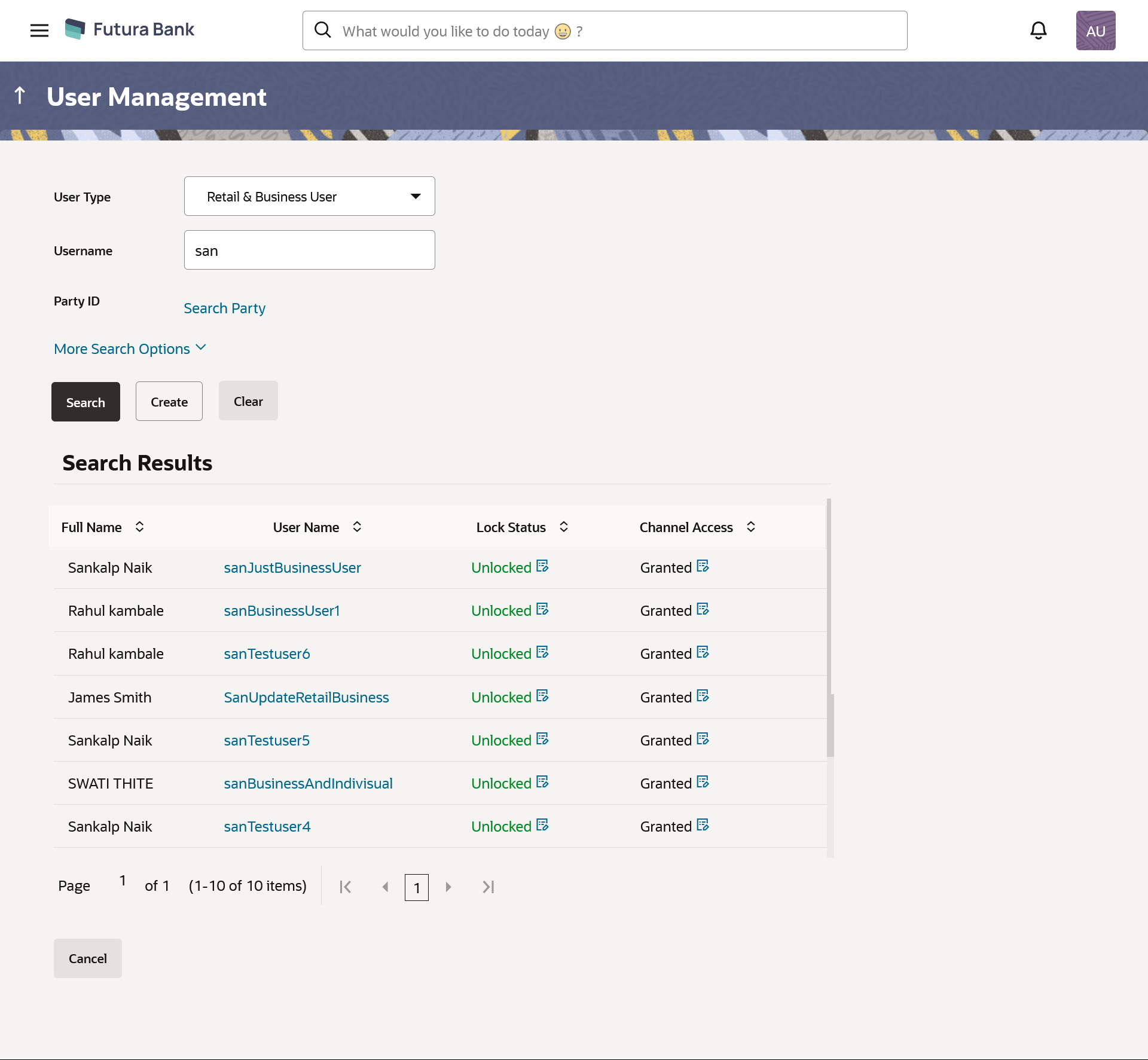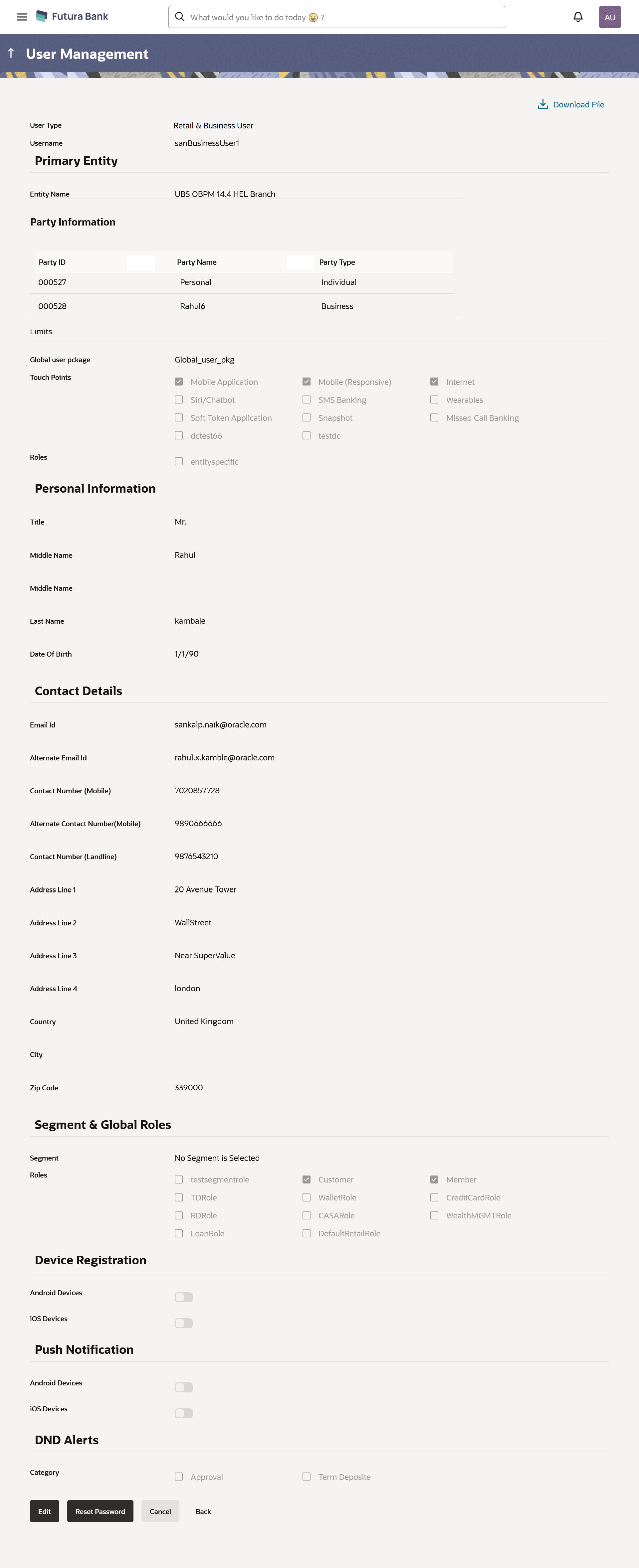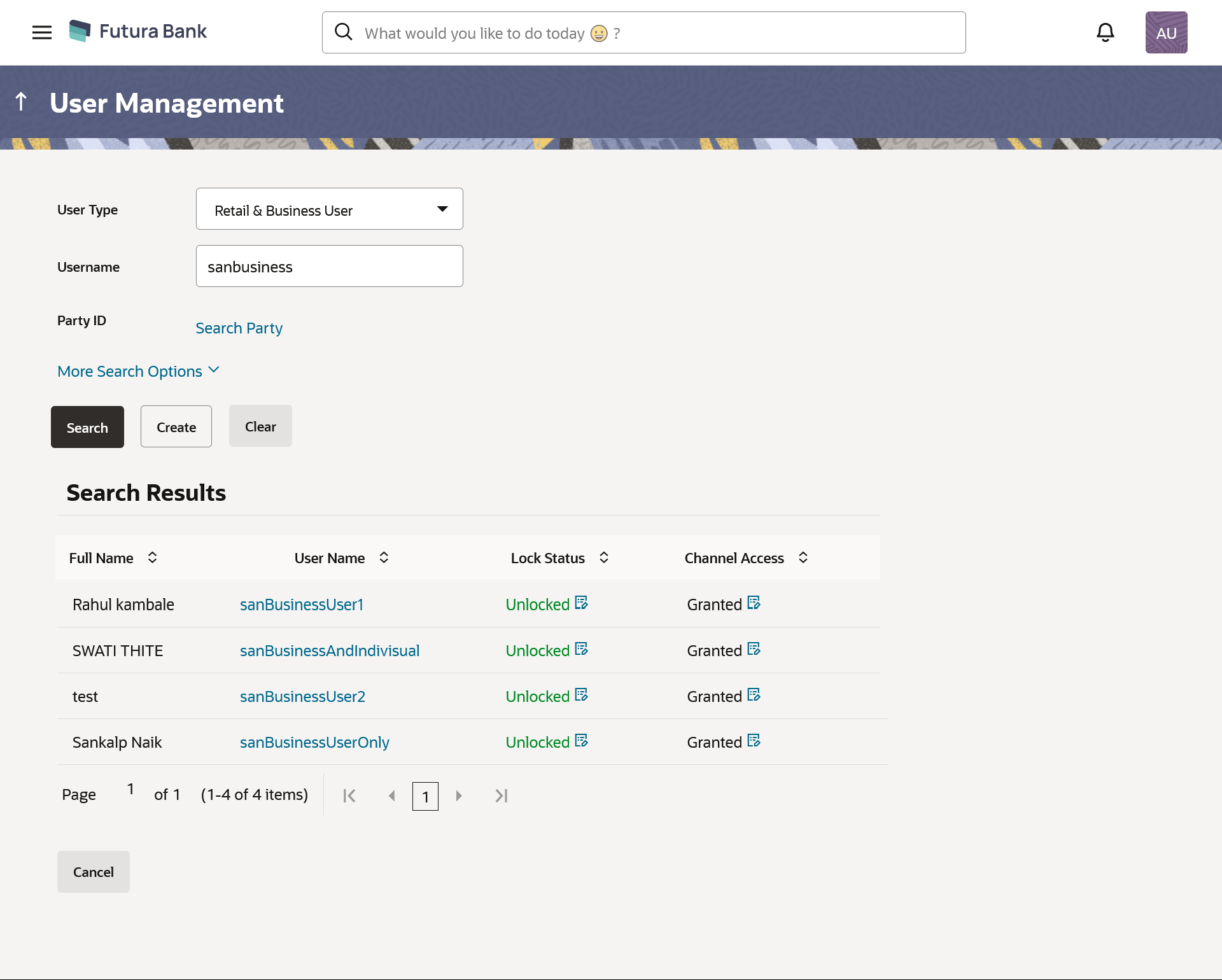3.2 User Management - Search and View
Using this option, System/ bank administrators can search and view details of the existing users. Administrator selects the user type of the user to be searched.
System/ bank administrators can also change the user status or the channel access permission for a user using this screen.
Default search is available with Username, but the user can also be searched by providing other details like First Name, Last Name, Party ID. Email ID and Mobile Number.
If the user type is selected as Retail & Business User, then the user can be searched based on the Party ID. An option is provided to search the party present in the core banking system using either the party ID or party name. The matching results are displayed on the screen.
If party ID or party name are provided partially, then a like search is run and all the records matching the search criteria are listed. If the complete party ID is entered, then the party ID is validated by the core banking application. After the core banking application validation is successful, party name gets displayed on the screen. In the result grid, the parties are listed with both Party ID and Party Name. User can select the record by clicking on the Party ID from the list.
To search for a user:
- Navigate to one of the above path.
The User Management screen appears.
- Enter the search criteria, click
Search.
The search results appear on the User Management screen based on the search parameters.
OR
Click Cancel if you want to cancel the transaction.
OR
Click Clear if you want to reset the search parameters.
Figure 3-6 User Management - More Search Options
Table 3-2 Field Description
Field Name Description User Type Type of user to be searched. The user can be:
- Corporate User
- Administrator
- Retail & Business User
User Name To search the user with the user name. Partial search is allowed. The User ID is case insensitive.
More Search Options Below fields appears if you click the More Search Options link.
First Name Allows to search based on first name or given name of the user. Last Name Allows to search based on last name/ surname of the user. Email Allows to search based on email id of the user. Mobile Number Allows to search based on mobile number of the user. Channel Access Allows to search based on channel access of the user. Party ID Allows to search based on Party id. This field appears if you select Retail & Business or Corporate User option from User Type list.
- Navigate to the above path.
The User Management screen appears.
- Enter the search criteria and click
Search in the User
Management screen
The search results appear based on the search parameters.
Figure 3-7 User Management - Search Results
Table 3-3 Field Description
Field Name Description Search Results Full Name First name and last name of the user. User Name User Name of the user. Status Status of the user. Locked or Unlocked. Channel Access Indicates whether channel access is granted. Click  icon to grant / revoke access
rights.
icon to grant / revoke access
rights.
Note:
Channel access feature will only be available with DB authenticator as Identity Management System. - Click the User Name link of
the record for which you want to view the user details.
The User Management - View screen appears.
Table 3-4 Field Description
Field Name Description View User Type Type of user. The user can be:
- Corporate User
- Retail & Business User
- Administrator
User Name The name of the user.
This field appears if you select Retail & Business option from User Type list.
Group Corporate ID The group corporate ID mapped to the user is displayed. This field appears if you select Corporate User option from User Type list.
Party ID The party ID mapped to the user is displayed. This field appears if you select Retail & Business or Corporate User option from User Type list.
Primary Entity Party Information Party ID Displays the party ID mapped to the user.
This field appears if you select Retail & Business or Corporate User option from User Type list.
Note:
For Non Customer Corporates (counterparties on boarded by Corporates) the system will look for the party ID in OBSCF/OBCMS.Party Name Displays the Party Name of the party ID mapped to the user.
This field appears if you select Retail & Businessoption from User Type list.
Party Type Displays the Party type of the party ID. The party type can be Retail or Business.
Organization Organization that the user belongs to. This field appears if you select Administrator option from User Type list.
Manager Manager of the user. This field appears if you select Administrator option from User Type list.
Employee Number Employee number of the user. This field appears if you select Administrator option from User Type list.
Party Information This section is displayed if you select Retail & Business option from User Type list.
Party ID The party ID mapped to the user is displayed. Party Name Party Name of the party ID mapped to the user. Party Type Party type of the party ID mapped to the user. Limit This field appears if you select Retail & Business or Corporate User option from User Type list.
In case of multi entity setup, if the user has access to multiple entities, the limits package displayed will be the one associated to the default/home entity of the user. For business party transactions, a limit package maintained at the party level (as a part of party preference) will be considered and will be utilized.
Touch Points/ Group Name of touch points/ groups maintained under a specific entity for whom the limit packages are mapped. Package Name of the limit package mapped against specific touch points /touch point groups Selected Segment Segment of the user for which the application role is created. This field is displayed only for a Retail & Business user type. Roles Application roles mapped to the user.
In case of multi entity setup, these roles will be for the default/home entity of the user.
Touch Points Selected Touch Points The touch points (banking channels) selected for a user to perform transactions.
The touch points could be:
- Mobile Application
- Mobile (Responsive)
- Internet
- Missed Call Banking
- SMS Banking
- Wearables
- Snapshot
- Siri / Chatbot
- API Access
- Soft Token Application
Limits & Roles User Groups Displays the user groups that are assigned to the user. This field is displayed only for a corporate user type. Personal Information This section is displayed if you select Retail & Business & Administrator option from User Type list.
User Name Name of the user (login ID) of the user. Title Title of the user. The options are:
- Mr
- Mrs
- Miss
- Ms
- Dr
- Master
First Name First name of the user. If user type is Retail & Business , value is fetched from the core banking application and defaulted.
Middle Name Middle name of the user. If user type is Retail & Business , value is fetched from the core banking application and defaulted.
Last Name Last name/ surname of the user. If user type is Retail & Business , value is fetched from the core banking application and defaulted.
Date of Birth Date of birth of the user. If user type is Retail and Business User, value is fetched from the core banking application and defaulted.
Contact Details This section is displayed if you select Retail & Business & Administrator option from User Type list.
Email ID Email id of the user. If user type is Retail & Business , value is fetched from the core banking application and defaulted.
Alternate Email ID Alternate email id of the user. If user type is Retail & Business User, value is fetched from the core banking application and defaulted.
Contact Number (Mobile) Mobile number of the user. If user type is Retail & Business , value is fetched from the core banking application and defaulted.
Alternate Contact Number (Mobile) Alternate mobile number of the user. If user type is Retail & Business User, value is fetched from the core banking application and defaulted.
Contact Number (Land Line) Phone number (land line) number of the user. Address Line 1-4 Address of the user. If user type is Retail & Business , value is fetched from the core banking application and defaulted.
Country Country of the user. If user type is Retail & Business , value is fetched from the core banking application and defaulted.
City City in which the user resides. If user type is Retail and Business User, value is fetched from the core banking application and defaulted.
Zip Code The postal code of the city in which the user resided. If user type is Retail & Business , value is fetched from the core banking application and defaulted.
Segment & Global Roles
This section is applicable only for Retail type of user.
Segment View the segment assigned to the Retail user. User Groups And Global Roles User Groups The list of all user groups to which the selected user belongs. User Group is applicable only to Corporate Users and Administrators.
Note:
- This information is read-only and hence cannot be modified.
- If a particular user needs to be removed from a user group, then the administrator must manually go to the particular user group screen and remove the user.
Roles The global roles which are mapped to the users. Device Registration This section is applicable only for Corporate type of user
.Android Devices This option shows if the user has registered Zig Bank application on any android devices/s. Enabling of the device happens when the user installs and registers on the app on the android device. Administrator cannot manually enable the device. If the Administrator deregisters the device, the user gets logged out from all the android devices and his alternate login gets disabled from all the android devices on which the user has installed the application.
iOS Devices This option shows if the user has registered Zig Bank application on any iOS devices/s. Enabling of the device happens when the user installs and registers on the app on the iOS device. Administrator cannot manually enable the device. If the Administrator deregisters the device, the user gets logged out from all the iOS devices and his alternate login gets disabled from all the iOS devices on which the user has installed the application.
Push Notifications This section is applicable only for Corporate type of user.
Android Devices This option shows if the user has registered for push notifications for android devices. Enabling of the push notification is done by user himself and administrator cannot do the same.
If the administrator disables this, the user will stop getting notifications as a pop-up message (push notification) on the user's registered mobile number.
iOS Devices This option shows if the user has registered for push notifications for iOS devices. Enabling of the push notification is done by user himself and administrator cannot do the same.
If the administrator disables this, the user will stop getting notifications as a pop-up message (push notification) on the user's registered mobile number.
Note: To receive push notification user will have to allow the same on the device settings.
Primary Entity Details Entity Name Primary Entity name associated to the user. Touch Points/ Group Name of touch points/ groups maintained under a specific entity for which the limit packages are mapped. Roles For the primary entity selected/ added, system will default the roles same as that of home entity of the user. The administrator cannot define separate roles for each of the entities. Map Parties This section is applicable only for Corporate type of user.
Primary Party Primary Entity name associated to the user. Accessible Parties Accessible Entities associated to the user. Limits Limits attached to the user. Touch Points Name of touch points/ groups maintained under a specific entity for which the limit packages are mapped. Map Roles DND Alerts DND Alerts The list of categories for which DND is configured can be enabled or disabled using this option. Accessible Entity Details This section is applicable only to Retail or Admin user only. Entity Name Accessible Entity name associated to the user. Limits - Touch Point/Groups Limits package associated to the user for the accessible entity. This field is only applicable for Retail & Business and corporate users. For Retail Party transactions, the limit package maintained at the user level will be considered and utilized. For business party transactions, a limit package maintained at the party level (as a part of party preference) will be considered and utilized. Touch Points/ Group Name of touch points/ groups maintained under a specific entity for which the limit packages are mapped. Package Name of the limit package mapped against specific touch points /touch point groups. Roles For the accessible entity selected/ added, system will default the roles same as that of home entity of the user. The administrator cannot define separate roles for each of the entities. - Click Edit to edit the user
details.
OR
Click Reset Password to reset user’s password. For more information refer, Reset password section.
If user clicks ‘No’, the action gets cancelled.
OR
Click Cancel to cancel the transaction.
OR
Click Back to navigate to the previous screen.
OR
Click
 icon to download the user details.
icon to download the user details.
User Management - Change user status
This section allows you to lock and unlock a user.
- Navigate to the above path
The User Management screen appears.
- Enter the search criteria, click
Search.
The search results appear on the User Management screen based on the search parameters.
- Click
 icon in the Status column to lock / unlock a
user.
icon in the Status column to lock / unlock a
user.
The User Status Maintenance screen appears.
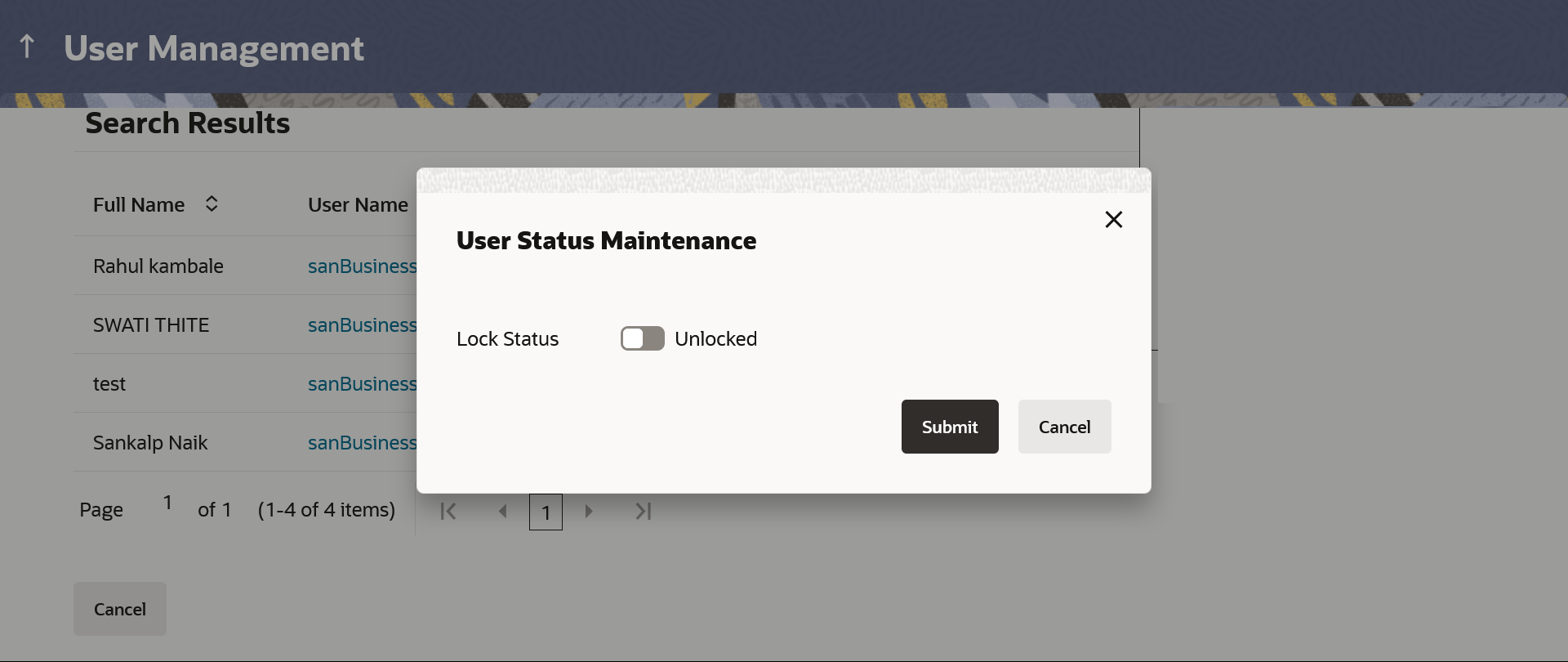
Description of the illustration lockunlockuser2.png - In the Lock Status field move the slider to lock / unlock a user.
- In the Reason field enter the appropriate description.
- Click Submit to
save.
OR
Click Cancel to close.
User Management - Channel Access Permission
Note:
Channel Access feature is only available and displayed if the Application is configured on DB Authenticator as Identity Management system.- Navigate to the above path.
The User Management screen appears.
- Enter the search criteria, click
Search.
The search results appear on the User Management screen based on the search parameters.
- Click
 icon in the Channel Access column to grant /
revoke channel access to a user
icon in the Channel Access column to grant /
revoke channel access to a user
The User Status Maintenance screen appears.
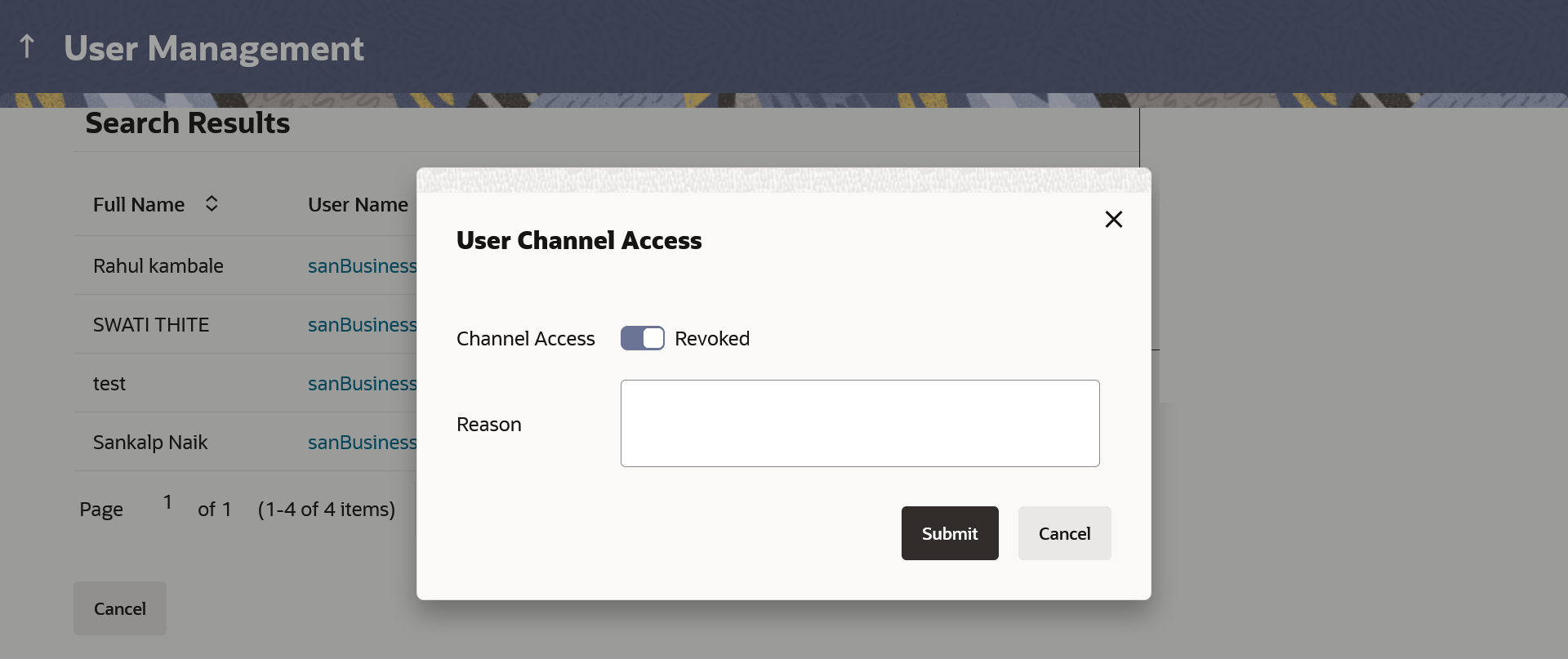
Description of the illustration channelaccess2-grantrevoke.png - In the Channel Access field move the slider to grant / revoke channel access rights for a user.
- In the Reason field enter the appropriate description.
- Click Submit to
save.
OR
Click Cancel to close.
Parent topic: User Management

